|
DLI 8800 Mobile POS Tablet
A rugged and very compact point-of-sale tablet computer for magstripe reading, barcode scanning and contactless payments
(by Conrad H. Blickenstorfer, with photography by Carol Cotton)
Laporte, Indiana based DLI was founded in the early 1990s as a manufacturer and reseller of wireless data collection devices. They carry mobile computers, vehicle mounted terminals, handhelds, rugged ultra-mobile tablets, and rugged yet lightweight tablet computers like the DLI 8800 examined in this report.
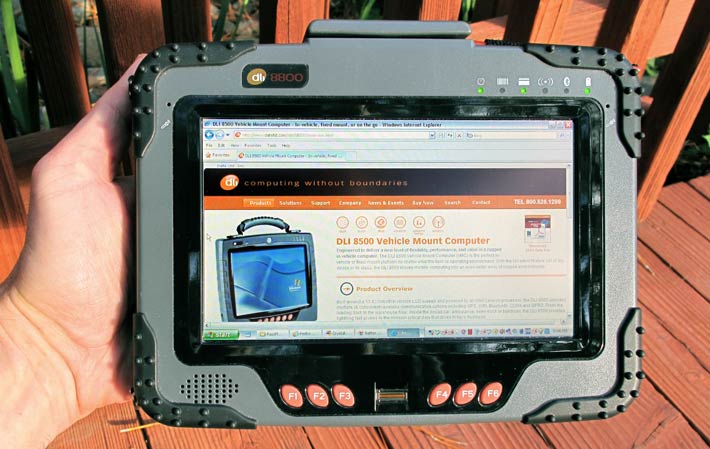
Introduced the end of 2009, the DLI 8800 predates the start of the iPad era by a few months, but actually predicted the emerging demand for small, lightweight tablet computers not just for the consumer market, but also for tough on-the-job assignments that require ruggedness and the ability to survive a drop or two, rain, vibration and whatever else can happen in the field.
That said, the DLI 8800 is not meant to be an ultra-rugged fortress of a computer. Instead, it was specifically designed with point-of-sale (POS) applications in mind. POS includes "line busting" (i.e, bringing checkout directly to customers waiting in line); portable retail at events, parks, hotels, or resorts; and "roaming customer service," where customers can request information or conduct transactions throughout stores. All this requires a tablet that can scan barcodes, read mag cards, and conduct contactless transactions, yet is light enough to be carried around all day.
To handle all those POS jobs, DLI created a tablet computer that measures a very compact 8.25 x 6.3 x 1.4 inches (a footprint smaller than that of a netbook) and only weighing a bit over two pounds, hardly more than Apple's far more fragile iPad tablet and less than any netbook. For processing power, DLI uses the same power-efficient 1.6GHz Intel Atom Z530 chip doing duty in their 8400 ultra-mobile rugged tablet.
While our review unit came with the Windows XP Tablet PC Edition, depending on its intended application, the device can be configured with a variety of Microsoft operating systems (Windows 7, XP Pro, XP Tablet Edition, Embedded Standard) or Ubuntu Linux, and run on either a 60 or 80GB shock-mounted hard disk or an industrial SSD with capacity up to 64GB. Despite its minuscule weight, the DLI 8800 has a reasonably powerful hot-swappable Li-Ion battery that should provide four to five hours of operation between charges, enough for POS environments where users will likely be able to plug in or dock their machines.
Our review unit came with a polarized resistive touchscreen for indoor/outdoor viewing (a digitizer is available). The 7-inch display has a strong 350 nit backlight and offers WSVGA (1024 x 600 pixel) wide-format resolution. There are two USB 2.0 ports, an RS232 serial port, gigabit Ethernet, a biometric reader, and a pass-through connector to a cradle. Also available are an integrated Honeywell Adaptus Imager, an integrated 3-track magstripe reader, RFID, 802.11a/b/g/n WiFi, Class 2 Bluetooth, and various WWAN radios supported by Verizon, AT&T, Sprint, and T-Mobile.
Designing a rugged tablet
While industrial market tablets have been around since the dawn of pen computing some 20 years ago, for the better part of that time the category has played a very low-key role of filling the needs of certain vertical and industrial market customers. Microsoft tried to change that about ten years ago with the Tablet PC platform, but the company's unwillingness to create a true tablet-oriented software platform limited consumer market acceptance. In 2010, the surprise success of the iPad brought tablets into the mainstream, and also fundamentally changed consumer expectations as to how a tablet should operate.
The iPad's trail-blazing performance represents both an opportunity and a challenge to industrial market tablet manufacturers. The opportunity is the greatly increased interest and acceptance of the tablet form factor. The challenge is that everyone now expects a tablet to work as effortlessly and elegantly as the iPhone and iPad, with multi-touch and pinching and panning and zooming and all. 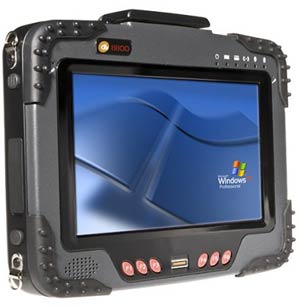 That's a tough challenge indeed as, for now, the needs of most vertical market customers (gloves, ruggedness, Windows) cannot be met with iPad-style technology. That's a tough challenge indeed as, for now, the needs of most vertical market customers (gloves, ruggedness, Windows) cannot be met with iPad-style technology.
So when assessing the DLI 8800, one should not compare it to a consumer device such as the iPad, but against older, larger and heavier tablets. In fact, the best description would be that the DLI 8800 is a ruggedized tablet version of a netbook. Compared to a full-size notebook computer, a netbook is much smaller, lighter and handier. Likewise, compared to a full-size tablet, the DLI 8800 is smaller, lighter and handier without giving up much, if any, performance or functionality.
Unlike its DLI 8400 sibling that incorporates a thumb-type keyboard, the DLI 8800 is a true tablet and all input is via stylus, touch, onscreen keyboard or the six hardware function buttons (you can, of course, connect an external USB keyboard, which comes in handy when the tablet is in its dock). Note, though, that DLI equips this tablet with a resistive digitizer that's best used with a stylus, as opposed to using projected capacitive technology popularized by Apple with the iPad. Also note that there is no navigation diamond or touchpad as is sometimes found in this type of device.
As we've come to expect from DLI, the design of the 8800 merges consumer technology style, appeal and detail with industrial quality material and manufacturing. The housing consists of a matte-gray ABS+PC polymer that's very tough, highly resistant to impact, and not prone to getting scratched. The overall design is simple, elegant and purposeful, and you can tell right off the bat that this is a very well made unit. There is no chrome, trim or exposed metal here. The only glossy element of the design is a shiny black bezel surrounding the matte 7-inch display and encompassing the function buttons and fingerprint scanner. A rubberized band goes around the entire unit and the front four corners are protected by thin rubber bumpers that give the unit a tough and rugged look.
Looking at all sides of the DLI 8800
The composite picture below shows the DLI 8800 from the front and all four sides. Here it is immediately obvious that this is still a rugged tablet computer, and not one of those slender consumer slates. You can also see that ports and connectivity are distributed along all four sides.
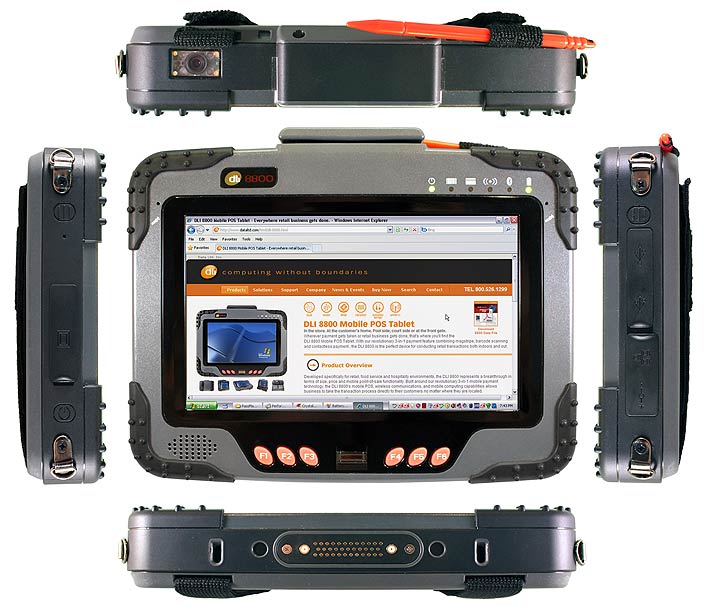
While we left the protective rubber plugs in place for the product photography, here's what the DLI 8800 offers:
- 2 standard-size USB 2.0 ports
- A standard RJ45 gigabit LAN jack
- A standard DB-9 RS232 serial port with +5 Volt on pin 9
- A surface mount 35-pin pass-through dock connector with two RF antenna pass-throughs.
On top of the unit is the integrated 3-track, single-head OPOS/JPOS-compliant mag card reader and the window of the integrated JPOS-compliant Adaptus imager.
Both the left and right side have two metal D-rings each. They can be used to attach a carry or shoulder strap in any position. Each side also has a scanner button.
Compared to the DLI 8400 ultra-rugged UMPC with which the DLI 8800 shares many components, there is no external card slot and there are no audio jacks.
The two pictures below show the 8800 from the back. On the left side is DLI's official product shot of the unit with its single battery installed and both Velcro handstraps as well. Note that he orange stylus can be inserted into a loop on the strap. The adjustable straps make it easy to carry the computer with one hand, either left or right.
The picture to the right shows our review sample with its battery removed. Covered by the right velcro strap is a SIM Card slot in the battery compartment.

Desktop/vehicle cradle: additional ports and extra batteries
While POS tablet computers such as the DLI 8800 are designed to be carried around and used on the job, most will also be used in offices or mounted in vehicles. This means that you need a good dock/cradle. Our evaluation unit came with the optional Desktop/Vehicle Cradle that essentially transforms the DL 8800 into a desktop machine or stationary POS solution. The cradle replicates the unit's two USB ports and the RJ45 LAN jack, and adds a third USB port as well as VGA video-out. The device securely snaps into place and can even be locked.
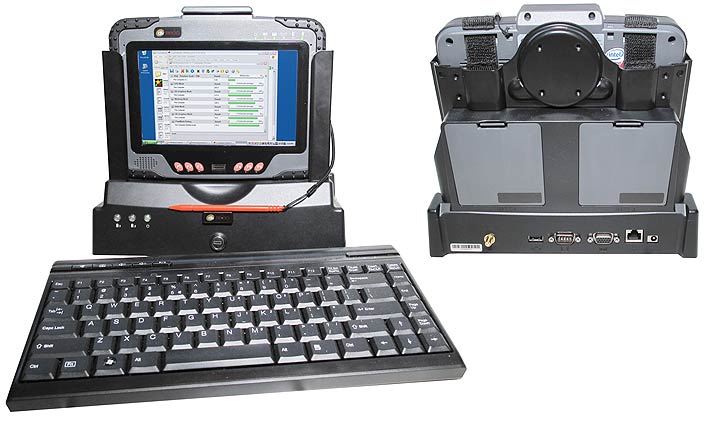
The image above shows our review unit securely DLI 8800 positioned into the Desktop Cradle and connected to the optional external USB keyboard. There is a standard VESA mount, and the pass-through antenna port means that wireless communication will never be interrupted as the computer is inserted and removed from the cradle.
Also note that the dock can accommodate two extra batteries. This means that the dock can charge a couple of spares, or triple the DLI 8800's total battery life when away from a power outlet.
A peek inside the DLI 8800
We generally do a fairly detailed analysis of what's inside any rugged device that passes through the RuggedPCReview.com lab. This shows whether the inside of a system is as rugged as the outside, and whether it'll likely hold up. Here are some of our observation as we perused the insides of the DLI 8800:
- The two clamshell halves of the DLI 8800 ABS+PC polymer housing provide a tight fit, but there does not appear to be an O-ring seal for extra protection.
- Inside the unit is a roughly 185 x 140 mm DLI-branded motherboard. It is clean, highly integrated and very well organized. Visuals are dominated by a large finned cooling sink that covers both the chipset and the board's sole SO-DIM memory module slot. I/O is directly mounted onto the motherboard (as opposed to sitting on separate I/O boards). I/O port openings in the housings are not sealed; they depend on a tight fit by the external rubber plugs for a protection.
 What looks like cooling vents on the back of the unit is actually just that. The slots go through the housing. However, they are blocked off with black tape inside, providing a seal against dust and water intrusion. What looks like cooling vents on the back of the unit is actually just that. The slots go through the housing. However, they are blocked off with black tape inside, providing a seal against dust and water intrusion.
- The main battery is a 14.8V 2,500mAh 37 watt-hour Li-Ion rechargeable. It is externally accessible and snaps into the backside of the computer, becoming part of its design. There is no O-ring seal between the battery and the housing, and there are openings to the inside of the system inside the battery compartment. The battery itself has four LEDs that display charging status.
- The DLI 8800 also uses a 11.2 Volt 190mAH 2.1 watt-hour rechargeable backup battery. It is sitting underneath the hard disk and can be replaced. The backup battery managed to keep the system going during a roughly 30 minute examination of the insides of the system.
- The disk assembly sits inside a soft black rubber boot similar to the boots that are often used for protection of smartphones.
- A single SIM slot is mounted on the motherboard, where it is accessible via the battery compartment. There do not appear to be additional card slots.
- The few other daughterboards and modules are all held in place with screws; they cannot rattle loose.
Ruggedness
While durability and reliability on the job are requirements for any POS application, POS devices are likely to encounter somewhat less abuse in the field. This means that the DLI 8800 can do with a bit less protection and toughness, though it mostly shares the inherent ruggedness of all DLI platforms. Still, ruggedness inevitably comes at the cost of extra size and weight, and so this POS-oriented unit makes do with a bit less cladding and protection, and somewhat lower ruggedness specs in some areas.
What you get here is the ability to survive multiple four-foot drops to bare concrete, a very wide operating temperature range of -4 to 122 degrees Fahrenheit, the ability to withstand fairly severe vibration, and IP54 sealing against dust and liquids. Now what does that mean?
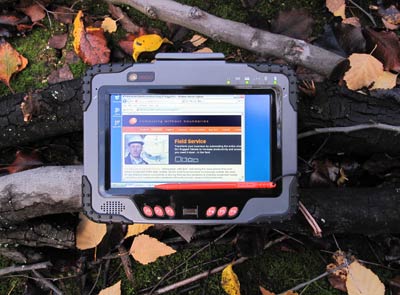 In essence, a four-foot drop to concrete means that the tablet can survive a drop to any surface if it slips out of your hands while you carry it around or are working on it. The DLI 8800 doesn't have the large rubber bumpers that give its DLI 8400 sibling its characteristic look while providing very substantial additional protection. That's because the 8400's bumpers are so large as to significantly increase the unit's footprint. Instead, the 8800 has much smaller bumpers protecting the front four corners only. Shock protection is less for the 8800 than the 8400 (20G operating for 11ms vs 40G). In essence, a four-foot drop to concrete means that the tablet can survive a drop to any surface if it slips out of your hands while you carry it around or are working on it. The DLI 8800 doesn't have the large rubber bumpers that give its DLI 8400 sibling its characteristic look while providing very substantial additional protection. That's because the 8400's bumpers are so large as to significantly increase the unit's footprint. Instead, the 8800 has much smaller bumpers protecting the front four corners only. Shock protection is less for the 8800 than the 8400 (20G operating for 11ms vs 40G).
The -4 to 122 degree Fahrenheit operating range covers just about any conceivable POS application, though the high end is a bit less than the 8400's ability to keep working even a 140 degrees!
The device carries IP54 sealing, where the "5" means the unit is protected against dust (though small, non-harmful deposits are allowed under this classification), and the "4" means it's protected against water sprayed from all directions, again with limited ingress permitted. This means the 8800 can handle operation in moderately dusty environments and it can handle a bit of occsional rain. However, we wouldn't push it as there are no O-ring seals anywhere, and the ports all rely on paroperly seated rubber plugs for protection.
For the DLI 8400, the company specifically listed MIL-STD-810F testing in various categories. DLI 8800 specs include fewer ruggedness categories, so if things like salt fog resistance or high altitude operation are required, consult with DLI.
Powered by Intel Atom
The DLI 8800 is based on Intel's Atom processor architecture. Intel introduced the Atom platform a couple of years ago as an optimized solution for devices that did not require Intel Core processor performance or simply needed a processor solution that generated less heat and used less battery power. Intel successfully met its goals, and Atom processors have been hugely popular and a hit for Intel, with millions of Atom-powered netbooks sold, and the chip being used in a growing number of vertical market devices. So let's take a look at Atom's background.
In an attempt at fending off growing criticism over its rather average mobile processor offerings, Intel's goals for the Atom were low power consumption and low cost while still delivering adequate (or, as is often used, "targeted") performance. To achieve that, the Atom platform was an entirely new design that allowed Atom chips to require much less power than even the slowed-down ultra-low voltage mobile versions of Intel's Core processors. There is the inevitable trade-off, of course. In order to preserve power and keep costs down, most Atom chips only have one core and instead use HyperThreading, an older Intel technique that uses two threads while increasing power consumption by only about 10%.
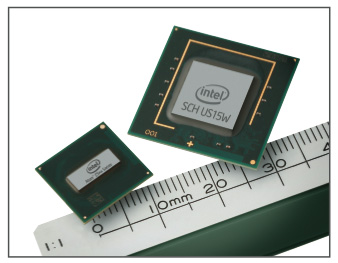 Atom processor architecture is fairly simple (if any processor with its millions of transistors can be called simple) but includes a wealth of power conservation features. A special bus mode minimizes power needed to transmit data to the processor. During periods of inactivity, cache is flushing cache data to system memory. Other Intel power conservation modes were improved and a new standby mode can essentially shut down the processor. Combined, these measures can result in greatly reduced overall power consumption while still providing acceptable performance. Atom processor architecture is fairly simple (if any processor with its millions of transistors can be called simple) but includes a wealth of power conservation features. A special bus mode minimizes power needed to transmit data to the processor. During periods of inactivity, cache is flushing cache data to system memory. Other Intel power conservation modes were improved and a new standby mode can essentially shut down the processor. Combined, these measures can result in greatly reduced overall power consumption while still providing acceptable performance.
The Z530 processor used in the DLI 8800 is part of the original Z5xx family of Atom processors, codenamed "Silverthorne" (see Intel brochure on the Z5xx). DLI chose the original 13 x 14 mm package version as opposed to the "large footprint" "P" version with a 22 x 22 mm package size. Intel targeted the Silverthorne chips at mobile internet devices (MIDs), but they have also become quite common in rugged mobile and embedded devices. The Silverthorne processors use the "Poulsbo" System Controller Hub that was developed specifically for the Z5xx Series. The chipset—which supports PCI-E, SDIO, DDR2, LVDS, ATA 100, LPC and more—uses only about 2.3 watts, which means the total power consumption of the CPU and chipset combined isn't even 5 watts. That is only a small fraction of what a conventional Intel notebook processor and chipset uses. And the Poulsbo chipset even has hardware support for H.264 and other HD decoding (see Intel brochure on the "Poulsbo" US15W SCH).
Note by now Intel is offering a variety of different single and dual core Atom chips (almost 40 as of late 2010) and chip families (the D and E series have been added to the original Z and N series) targeted at different devices and operating at different clock speeds. However, the 1.6GHz Z530 used in the DLI 8800 is far and away the most popular chip in Atom-powered vertical market devices and it won't go away anytime soon.
Power efficiency
The primary selling point of Intel's Atom chips is low power consumption. That generally goes hand in hand with low heat generation, both good qualities to have in a mobile device. The Z530 processor has a maximum thermal design power of just over two watts, compared to many times that number even in mobile Intel Core i5 or i7 processors. How well does the DLI 8800 take advantage of its miserly chipset, and does low power consumption turn into long battery life?
While somehow the DLI 8400 didn't get along with our standard power draw benchmark, Passmark's BatteryMon, the DLI 8800 had no problems with it. With Windows power management set to maximum battery life, and screen brightness turned down, we recorded power draws just under seven watts. Dividing the DLI 8800's battery capacity of 37 watt-hours by seven watts indicates a theoretical operating time between charges of well over five hours. And with the display turned off but the computer still awake, power draw dipped into the mid-four watt range, theoretically good enough for much longer battery life than the officially quoted four hours.
Battery discharge tests, however, don't necessarily mean much in real life where battery drawdown depends on the complex interaction between processor power management, operating system power management, power settings, and actual use. Doing POS transactions with down-time inbetween may mean almost full-shift battery life, whereas continuous operation with the display always on will probably drain the battery in a couple of hours or so.
Overall, it appears that DLI did a very good job putting the 8800's Atom processor's power management and inherently low power consumption to good use. When asked how they did it, their comment was, "A lot of effort was done to consume the least power possible. The Atom is capable of going into low power states and we took advantage of it." True, that.
Performance
The flipside of the Atom processor's efficiency and relative simplicity is that it operates at lower performance levels than Intel's Core processors. When describing Atom-based performance, the word "targeted" is often used, i.e. performance is targeted towards certain applications where the chip is "fast enough." That's not a bad approach. Tens of millions of netbooks using Atom processors are fast enough, with users being fully aware that an inexpensive netbook cannot provide the same performance as a much more expensive Core-based computer. Are Atom chips fast enough for vertical market tablets?
Based on our benchmark library of Atom Z530 systems, we expected the DLI 8800 to feel about as fast as a standard consumer netbook and its relative performance compared to most full-size rugged tablets on the market to be at about the 60-65% level. More importantly, we wanted to see how the 8800 performs compared to systems based on the same chip architecture.
We used Passmark Software's PerformanceTest 6.1 that runs about 30 tests covering CPU, 2D graphics, 3D graphics, memory, and disk and then computes scores for each category and an overall PassMark score. For comparison, we're listing RuggedPCReview benchmark results for other small tablets using the Z-Series Atom processor. Here are the results:
|
PERFORMANCE COMPARISON
|
DLI
|
DLI
|
Logic Instrument
|
Panasonic
|
Handheld
|
Samwell
|
|
Model
|
DLI 8800
|
DLI 8400
|
FieldBook
|
H1 Field
|
Algiz 7
|
SR820
|
|
Processor
|
Intel Atom Z530
|
Intel Atom Z530
|
Intel Atom Z530P
|
Intel Atom Z540
|
Intel Atom Z530
|
Intel Atom Z530
|
|
CPU Speed
|
1.60 GHz
|
1.60 GHz
|
1.60GHz
|
1.86Hz
|
1.60GHz
|
1.60Hz
|
|
Thermal Design Power (TDP)
|
2.3 watts
|
2.3 watts
|
2.3 watts
|
2.4 watts
|
2.3 watts
|
2.3 watts
|
|
CPU Mark
|
240.4
|
237.8
|
235.5
|
275.4
|
217.8
|
248.7
|
|
2D Graphics Mark
|
127.4
|
59.5
|
84.6
|
115.7
|
56.7
|
101.8
|
|
Memory Mark
|
116.5
|
209.5
|
224.4
|
242.7
|
208.7
|
222.5
|
|
Disk Mark
|
253.9
|
147.4
|
266.4
|
284.8
|
175.6
|
218.6
|
|
3D Graphics Mark
|
16.6
|
40.3
|
9.8
|
10.1
|
17.7
|
18.6
|
|
Overall PassMark
|
176.3
|
144.6
|
170.3
|
191.9
|
141.6
|
167.4
|
|
ALU
|
5485
|
5375
|
5339
|
6149
|
5050
|
5272
|
|
FPU
|
4493
|
4068
|
4330
|
5414
|
3629
|
4571
|
|
MEM
|
4077
|
4125
|
3706
|
4327
|
4143
|
3969
|
|
HDD
|
4510
|
3647
|
5197
|
5156
|
6804
|
3678
|
|
GDI
|
2092
|
1722
|
2752
|
1202
|
1866
|
2806
|
|
D2D
|
1015
|
893
|
1053
|
187
|
976
|
1048
|
|
OGL
|
347
|
332
|
344
|
400
|
326
|
346
|
|
Overall CrystalMark
|
22019
|
20162
|
22721
|
22835
|
22794
|
21690
|
The benchmark figures show that DLI did a good job implementing the Atom architecture and optimizing it for the 8800 platform. In the overall PassMark benchmark the DLI 8800 scored higher than any of its competitors using the same processor. In the overall CrystalMark benchmark results, all systems were bunched up tightly, most likely indicating that by now the industry has learned to squeeze every last drop of performance out of those low power processors.
That said, there are differentiators. For example, while all competitors except one (the Panasonic H1 Field) used the 1.6GHz Z530, the Panasonic used the 1.86GHz Z540, and that helped the Pana to the overall highest scores in both benchmarks. The Z540 costs more, but Atom processor costs are very low compared to higher end Core chips, and we're surprised that the Z540, Z550 (2.00GHz) and Z560 (2.13GHz) are not offered at least as an option as their power consumption is still extremely low (the Z530 has a max TDP of 2.5 watts compared to the 2-2.2 watts of the Z530).
As always, note that benchmarks are only an approximate indicator of performance, and that they can yield unexpected or misleading results when different memory, disk and operating system configurations are being compared. However, after conducting hundreds of benchmarks in the RuggedPCReview.com lab, we found that the bottomline is usually a good indication of a system's actual perceived performance.
In real live usage, the DLI 8800 feels quick and responsive, and there's no doubt it can handle any POS application and most other jobs. The sole qualifier is that Atom processors do have performance limits, so those with specific application requirements should first check if an Atom-based system can indeed handle their target applications.
We did notice one peculiar thing comparing the DLI 8800 with the DLI 8400 that we had in our lab a few months ago: Graphics performance is very different. The 8400's benchmarks were lower than expected in 2D graphics test but much higher than expected in 3D benchmarks, whereas the DLI 8800 scored high in 2D and about what we usually expect from a Z530 system in 3D (i.e. low). What does that mean? Well, unlike most Atom-based systems, the DLI 8400 was able to run 1080p video flawlessly whereas the DLI 8800 isn't. We don't know how DLI did it on the 8400 and HD playback is likely not important for a POS system, but it is a bit of a mystery.
Storage
Our DLI 8800 review unit came with a 4,200rpm 80GB Toshiba MK6028GAL hard disk. This is a 1.8-inch design with a Parallel ATA interface that's generally used in space-constrained applications. The MK8025AL, which is part of Toshiba's 25th generation of 1.8-inch drives, has an almost unbelievable 300,000 hours mean time to failure, which is almost 35 years.
The disk assembly weighs only over three ounces and uses very little power (around one watt while reading or writing, about 0.4 watt while idle). It operates silently. Its lower operating temperature limit of 41 degrees Fahrenheit, however, would appear to limit the 8800 to the same value as DLI does not seem to be using a disk heater. The DLI 8800 can also be ordered with a smaller 60GB hard disk or Solid State Disk (SSD) storage with 8, 16, 32, or 64GB capacity. Note that ruggedness specs apply to the hard drive model. SSD versions probably have certain performance advantages, and a small size SSD might be a good option for a Windows Embedded Standard implementation.
Wireless communication
For wireless communication, the DLI 8800 can be equipped with pretty much whatever it takes to stay in touch either via voice or data, and it also includes a variety of wireless data capture methods.
For WiFi, DLI specs indicate 802.11b/g/n is standard. If 802.11a support (operating on the 5GHz band) is required, 802.11a/b/g/n is optionally available. Both modules are Cisco CCX5 compatible. Our eval system, though, came with an Intel PRO/Wireless 3945ABG mini-PCIe module, so shipping versions probably include the PRO/Wireless 4965AGN module.
If wireless wide area network (WWAN) support is needed, DLI can ship the 8800 with an optional integrated cellular card that includes support for external antennas and can be used with all major cellular carriers (Verizon, Sprint, AT&T, T Mobile).
For short range wireless networking, Class 2 Bluetooth is available.
Voice communications is available via VoIP (Voice over IP) and can be used with the integrated dual microphone but since the DLI 8800 doesn't have audio jacks, you'll probably want to use a Bluetooth headset/microphone.
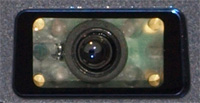 For barcode scanning, the DLI 8800 uses an integrated OPOS/JPOS-compliant (JPOS is a platform for electronic payment) Honeywell Adaptus imager. The Adaptus imager engine essentially combines a digital camera, powerful illumination and scanner aiming optics (crosshairs) in a package small enough to easily fit into compact tablets such as the 8800. For barcode scanning, the DLI 8800 uses an integrated OPOS/JPOS-compliant (JPOS is a platform for electronic payment) Honeywell Adaptus imager. The Adaptus imager engine essentially combines a digital camera, powerful illumination and scanner aiming optics (crosshairs) in a package small enough to easily fit into compact tablets such as the 8800.
One of the characteristic design elements of the DLI 8800 is its integrated magstripe reader. It is a 3-track, single-head unit that is OPOS/JPOS-compliant and gives the 8800 the mobile POS processing capabilities that are often required in hospitality, transportation, entertainment, etc.
Also included is an integrated 13.56 MHz RFID reader that's compatible with the ISO/IEC 14443 A/B spec for proximity cards, with ISO15693 (longer range reads) available as well. This is used for contactless payment systems.
Unlike the DLI 8400, the DLI 8800 does not provide GPS functionality. This might come in handy for geo-tagging of transactions. Likewise, the DLI 8800 also does not include cameras (the DLI 8400 has both a front and a rear mounted camera).
Very nice 7-inch display
Displays can make or break a mobile computer, and that's especially true for systems that are used outdoors and in bright sunlight. Outdoor operation mercilessly exposes display flaws, be it excessive glare, reflection, inadequate backlight, optical aberrations, etc. So how does the DLI 8800's display do in those areas?
Overall, the DLI 8800's LCD is pleasant to work with. In every day use the display feels neither too large nor too small for the size of the device. Likewise, the 1024 x 600 pixel resolution, while a bit low for today's complex web sites and applications in absolute terms, feels about right for the size of the display. That's important as users often have trouble adjusting to a large screen with low resolution or a tiny one with very high resolution.
The surface treatment of the display is exemplary. Most current consumer market computing devices, including tablets and phones, have "gloss" screens that look nice and crisp indoors, but generate horrible reflections outdoors. The 8800's display is on the matte side, but it isn't matte enough to swallow up all the light. Display viewing angles are important, too, so that users don't constantly have to reposition the device in order to see what's on the screen. Horizontally, the 8800's viewing angle is perfect; you can look at it from the side and the picture never changes. Vertically, the picture also remains visible at extreme angles, but when you turn the display up and away from you, there's a chromatic shift that changes colors.
As a mobile POS device, the DLI 8800 is going to be used outdoors and its display must be viewable and readable under a wide variety of lighting conditions. Even though the display's maximum backlight brightness is just 350 nits, it feels like more than that (a standard notebook display maxes out at around 200 nits).
The first picture below shows an indoor daylight comparison between the DLI 8800 and a Samsung Galaxy Tab. The Samsung is one of the first consumer market tablets to mount a credible challenge to the Apple iPad. It has a bright and very vibrant 1024 x 600 pixel 7-inch display and looks great indoors. The DLI 8800 has the same size display and the same resolution but is a bit brighter. The camera couldn't quite capture the brightness ranges and blew out the 8800's much brighter display. What it amounts to is that the 8800's 350 nits backlight is so bright that you never need to crank it up all the way indoors.
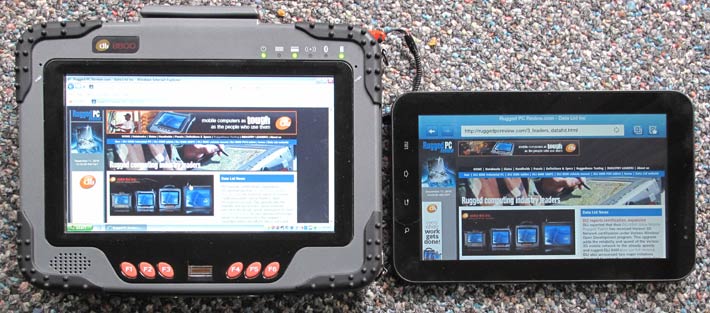
The second picture, shows the two devices outdoors, facing the sky on a moderately bright California winter morning. Most standard displays simply wash out outdoors as their backlights cannot compete with daylight, and that's what happens to the Samsung tablet here. The 8800 retains a good degree of readability, though in direct daylight an even stronger backlight would come in handy.
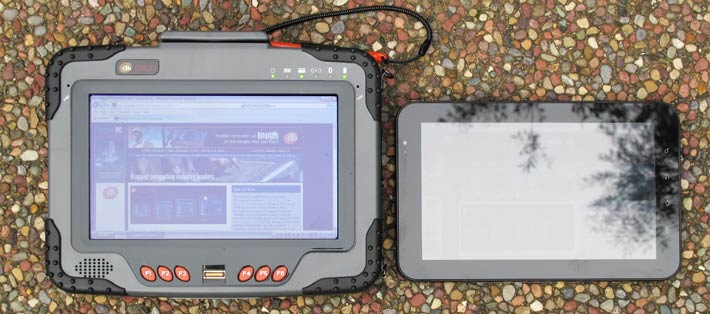
The 8800's 350 nits backlight, however, is plenty strong enough to make for a decent picture outdoors away from the sun. And in the picture below you can also see another hugely important property of the DLI display: no pesky refections! Whereas the Samsung tablet's glossy display practically becomes a mirror, there aren't any reflections whatsoever on the DLI display, a testimony to DLI's exemplary optical anti-glare and anti-reflection coatings.

The final comparison picture shows the two tablets outdoors from an angle. The Samsung display's glossy surface reflects so much that viewing becomes impossible (though it does have perfect viewing angles in all directions) whereas the DLI display remains quite viewable (the camera imposed some greenish tint where the eye actually saw a much cleaner picture). However, an extra hundred nits or so would still come in handy.
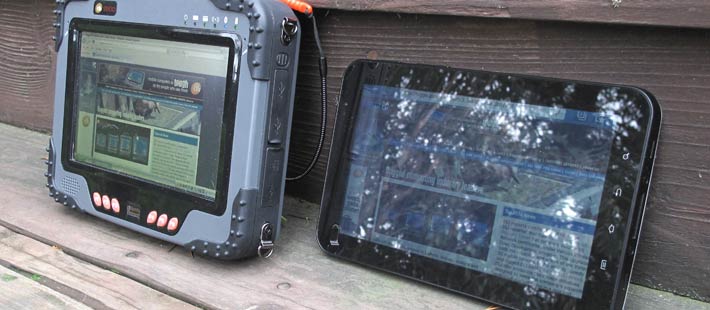
Good though it is, the DLI 8800 shares a modern problem with all those millions of netbooks: the 1024 x 600 pixel wide-format resolution sits smack between the old 800 x 600 pixel SVGA and 1024 x 768 XGA standard 4:3 aspect ratio standards. A lot of software screens and websites are still optimized for one of those two formats, and so it often feels as if part of the display is cut off. There's a fix for that by switching the 8800 to interpolated 1024 x 768 mode. The display won't be as crisp and things are a bit out of proportion, but it does the trick. Likewise, if you have a problem with the fairly high resolution on a smallish 7-inch display, you change that if you use Windows 7 (ours had XP on it) by switching to 125% magnification. This means text and pictures are larger, but you have to scroll more.
Digitizer
The DLI 8800 can be ordered either with a resistive touchscreen or an active digitizer. Our test unit had the resistive touchscreen, that can either be used with the supplied and tethered 4-1/2-inch orange plastic stylus or with a finger. It's configured with the PenMount Control Panel that includes three primary settings screens:
Calibrate handles touch calibration using 4, 9, 16, or 25 points, with 25 points offering the maximum accuracy. In advanced mode you can opt to show calibration data.
Setting lets you select either mouse emulation mode or click-on-touch, enable a beep sound to occur on pen down or pen up (or both), and even set its frequency and duration. I am not sure how that would be used, but in noisy vehicle operation, having auditory feedback to confirm a touch operation may come in handy. You can also engage a cursor stabilizer to eliminate cursor jitter, and you can set how the digitizer should handle right clicks.
Edge compensation determines how the digitizer acts along the perimeter of the display where it is sometimes hard to accurately control the cursor.
Below you can see the three PenMount configuration screens.

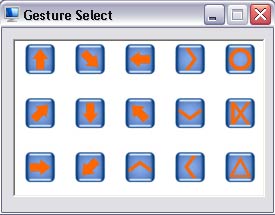 The PenMount control panel also lets you configure multiple monitors and map them for touch. You can also enable gestures and assign keys, applications or actions to a total of 15 simple gestures (see available gestures to the right). The PenMount control panel also lets you configure multiple monitors and map them for touch. You can also enable gestures and assign keys, applications or actions to a total of 15 simple gestures (see available gestures to the right).
While the DLI 8800's resistive touch panel works well (and especially so with the stylus), realize that resistive digitizer technology was designed to be used with a stylus. Touch works, but not very well. I mention that because ever since the iPad popularized projected capacitive touch, everybody expects finger touch to work on any touch screen. Also, note that resistive digitizers do not take full advantage of the many Microsoft and third party pen utilities that were all designed for use with an active inductive digitizer that is optionally available on this machine. The 8800 does come with the Microsoft Input Panel where you can enter text with the onscreen keyboard or with either a free-form or combed handwriting input window. Ink goes on very well, and there is almost none of the hesitation often seen in touchscreens that can interfere with recognition. This is good because potentially very valuable utilities such as Microsoft Journal all rely on the smooth flow of ink.
Bottom line here: while the DLI 8800's resistive digitizer works well for tapping and operating small click boxes and such, those who require ultra-smooth ink or cursor tracking (the cursor following the tip of the pen hovering above the display) should go for the active digitizer option. Ideally, a dual input panel option that supports both active pen and touch would be available as an option as well (or one that combines projected capacitive touch and electromagnetic, such as Wacom's G6 Multi-Touch that should be available for 7-inch displays by now).
Data entry methods: onscreen keyboards, recognition and inking
Unlike the DLI 8400 UMPC, the DLI 8800 does not have an integrated physical keyboard. You can, of course, connect an external USB keyboard to it, and that is by far the best method to type larger amounts of text into the 8800. There are, however, also two onscreen keyboards you can use to enter data. The pictures below show some of the onscreen data entry methods for 8800s running Windows 7. The gray onscreen keyboard is a DLI utility that closely mimics a standard physical keyboard. Microsoft's standard Windows 7 input panel that includes a comprehensive onscreen QWERTY keyboard can be toggled between modes to show standard F1-F12 function keys. The soft keyboard, however, requires the stylus and does not work well with touch (unless you use a fingernail).
The input panel also includes (shown on the right) two versions for handwritten input, one free form (top right), and one combed with individual boxes for each symbol (bottom). All applications work with these soft keyboards.

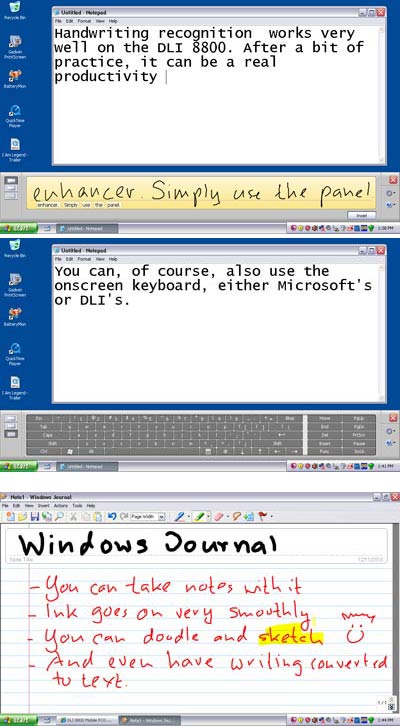 Any device equipped with a touchscreen offers potentially very useful additional functionality that is not available on a standard computer. That includes very flexible navigation and operation via tapping, and it also includes handwriting recognition, a technology that has seen its share of negative press (mostly based on unrealistic user expectations) but actually works quite well. Any device equipped with a touchscreen offers potentially very useful additional functionality that is not available on a standard computer. That includes very flexible navigation and operation via tapping, and it also includes handwriting recognition, a technology that has seen its share of negative press (mostly based on unrealistic user expectations) but actually works quite well.
First introduced in the original Windows XP Tablet PC Edition, the Microsoft Input Panel, in a somewhat improved version, remains part of Windows 7. Using it requires some practice, but it offers good handwriting recognition support. The recognizer can be used with its defaults, but it can also be trained to learn specific styles of handwriting and how to recognize whatever characters or words the recognition engine has problems with.
In order to take full advantage of a tablet such as the DLI 8800, users will want to install some of the many freely available utilities and applications specifically developed for pen and touch input. Microsoft itself offers the free "Experience Pack for Tablet PC" for download. It includes games and demonstrations, but it is unfortunately only available for the XP Tablet PC Edition and not for Windows 7.
The 8800 also comes with Microsoft Journal, a handy electronic inking notepad that, depending on your style of work, can be a very useful productivity tool. Journal lets you write notes in electronic ink, do drawings, convert handwritten notes to text, email your notes, and so on. There are different size and color pens, highlighters and also an eraser.
The software described represents just a few examples of handy tools available for touch and pen-based systems like the DLI 8800. There are many more, both utilities and full applications (we especially like the Snipping Tool), and they can add a lot of functionality on top of what is available in the standard operating system.
Do keep in mind that some of these utilities are optimized for touch or a stylus whereas others work best with an active digitizer. The availability of certain applications may help you decide between touchscreen or active digitizer.
Summary
The DLI 8800 is a compact, rugged tablet computer designed specifically for point-of-sale applications where retailers need to process payments, collect and exchange data, and communicate wirelessly both indoors and out. This means applications in line busting, roaming customer service, field sales, and just generally helping retail operations with sales, efficiency and superior customer service.
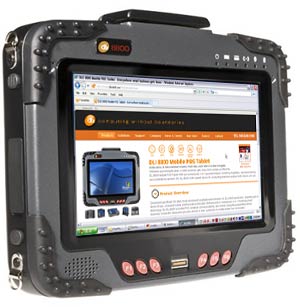 Measuring 8.3 x 6.3 x 1.4 inches and weighing just over two pounds, the DLI 8800 is much smaller and lighter than full-size rugged tablets but it is still large and powerful enough to serve as a full-function computer. Its 7-inch touchscreen (digitizer available) with 1024 x 600 resolution (1024 x 768 interpolated available) is small, but large enough to be useful. There is good wired connectivity on board, all connectors are standard size, and there is a wealth of wireless and data capture functionality. Measuring 8.3 x 6.3 x 1.4 inches and weighing just over two pounds, the DLI 8800 is much smaller and lighter than full-size rugged tablets but it is still large and powerful enough to serve as a full-function computer. Its 7-inch touchscreen (digitizer available) with 1024 x 600 resolution (1024 x 768 interpolated available) is small, but large enough to be useful. There is good wired connectivity on board, all connectors are standard size, and there is a wealth of wireless and data capture functionality.
Of particular interest for POS applications is the 8800's 3-in-1 payment processing functionality that includes an integrated magnetic card reader on top of the unit, an integrated barcode scanner, and RFID for fully contactless payment transactions.
Powered by a 1.6GHz Intel Atom Z530 processor, the DLI 8800 provides a balance between good performance and good battery life, thanks to the low heat dissipation of the processor all without the need of a fan. The device feels quick and responsive and the 37 watt-hour battery should easily last the quoted four hours between charges.
The 7-inch display is bright and very sharp, and offers good outdoor viewability without any glare. The resistive touch screen works well and is highly configurable. Electronic ink goes on smoothly enough for drawing and handwriting recognition, though some may prefer the optional active digitizer.
Given its small size and weight, the DLI 8800 has good onboard connectivity with two USB ports, serial, Gigabit LAN, fingerprint scanner, as well as additional connectivity (including VGA) via the optional dock. No audio jack, though, and no storage card slot. A SIM slot for use with an optional WWAN module resides underneath one of the batteries.
The DLI 8800's cleanly designed ABS+PC Polymer housing feels very solid and should be able to withstand most moderate accidents and exposure to the elements in the field. IP54 sealing means making sure there is not too much exposure to water, especially since ports and slots do not have additional sealing or plugs.
With the 8800 Mobile POS Tablet, DLI offers a compact, competent and very solidly made tablet that can run Windows 7 or several other operating systems. It's smaller and lighter than standard-size tablets, has most of the features and performance, and combines all common mobile POS transaction methods into one handy computing device.
-- Conrad H. Blickenstorfer
DLI 8800 Specs:
| Type |
Rugged mobile POS tablet
|
| Processor |
1.6GHz Intel Atom Z530 with 512KB L2 cache and 533MHz FSB |
| Display Chipset |
Intel "Poulsbo" System Controller Hub US15W |
| Video |
Intel Graphics Media Accelerator 500 (Intel GMA 500) with 3D graphics (integrated in US15W) |
| BIOS |
AMIBIOS XU64 |
| OS |
Windows XP Pro Tablet Edition, Windows 7 Pro, Windows 7 Ultimate, Windows Embedded Standard, Windows Embedded Standard 7, Windows POSReady 2009, Linux 2.6 (Ubuntu) |
| Memory |
2GB DDR2 SO-DIMM 533MHz |
| Display |
7.0" WSVGA 1024 x 600 pixel indoor/outdoor readable TFT with 350 nit LED backlight |
| Digitizer |
Touchscreen or active digitizer (standard or polarized)/1 |
| Keyboard |
6 programmable keys + 2 barcode scanner trigger keys (left and right) |
| Navigation |
Stylus, touch |
| Storage |
32 or 64GB industrial SSD (supports TRIM) |
| Expansion slots |
1 SIM (in battery compartment) |
| Housing |
Impact-resistant ABS+PC polymer |
| Size |
8.3 x 6.3 x 1.4 inches |
| Weight |
2.45 lbs. as tested with battery, bumpers and handstrap |
| Operating temperature |
-4° to 122°F (-20° to 50°C)
|
| Ingress protection |
IP54 |
| Drop |
Multiple 4ft to bare concrete |
| Shock |
Operating -20G, (11ms), Crash -75G (11ms)
|
| Vibration |
5~500Hz 1G PTP, MIL STD. 810F 514.5C-3 Highway truck vibration exposure |
| EMI/EMC |
FCC Class B, CE |
| Power |
14.8V 2,800mAH Li-Ion ("4-5 hrs of usage") |
| Interface |
2 USB 2.0, 1 DB9 RS232 (with +5V on pin 9), 1 RJ45 Gigabit LAN, biometric reader, integrated 3-track mag stripe reader; optional integrated Adaptus imager |
| Wireless options |
802.11b/g/n WiFi (Cisco CCX5) or optional 802.11a/b/g/n, optional Bluetooth Class 2, WWAN radios via integrated cellular card incl. support for external antenna (Verizon, AT&T, T-Mobile); optional integrated ISO14443 A/B, ISO15693 RFID reader
|
| Warranty |
Standard 1 year; available no-fault service coverage |
| Price |
inquire |
| Website |
DLI 8800 page |
| Brochure |
 DLI 8800 DLI 8800 |
| Contact |
1-219-362-1759 or 800-526-1299 tollfree |
(copyright 2010 RuggedPCReview.com)
|



